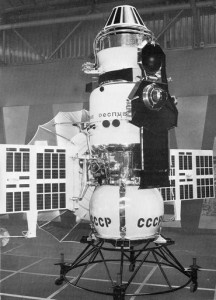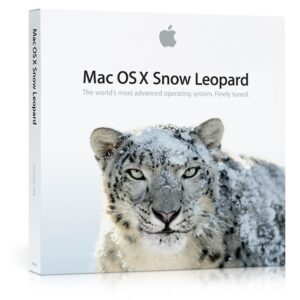Launch of Venera 4
June 12, 1967
The Soviet probe Venera 4 is successfully launched. On October 18, 1967, it will enter Venus’ atmosphere where it will become the first space probe to successfully return atmospheric data from another planet.
Speak & Spell
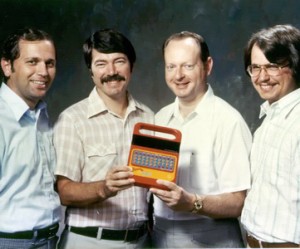
Texas Instruments Inc. introduces the Speak & Spell, a talking educational toy for children. The device features the first electronic duplication of the human voice on a single chip of silicon. It transformed digital information processed through a filter into synthetic speech and could store more than 100 seconds of linguistic sounds.
Crossing the Atlantic With Cable

Two ships head out to begin work on what will become the first operational Transatlantic cable. Previous attempts at laying a Transatlantic cable had failed. Designed for telegraph operation, the cable run is completed on August 5th and the first test message is sent on August 12th. However, after being used to send a total of 400 messages, including between US President James Buchanan and England’s Queen Victoria, the cable fails on September 18th and repair was not possible at the time. While this short-lived experiment seemingly ended in failure, it proved that it was possible to manufacture, lay, and operate a Transatlantic cable, setting up the feasibility of future global communications.
Life Finds a Way

The motion picture Jurassic Park premiers in Washington D.C. The highest grossing film in history at the time, the contributions of Jurassic Park to the field of special effects is perhaps as important as the original Star Wars movie 16 years prior. During the production of the movie, the decision was made to incorporate the use of computer generated imagery (CGI for short) in a large scale. By interweaving the use of CGI and animatronics, the movie’s special effects were of a realism unprecedented at the time (and for many still to this day). Jurassic Park jump started a wave of movies that made heavy use of CGI throughout the rest of the 90’s, and at present, the use of CGI pioneered by the movie is now entirely commonplace.
Apple Announces Snow Leopard
At their World Wide Developers Conference in San Francisco, Apple announced their next Mac operating system, Mac OS X 10.6, known as Snow Leopard. Snow Leopard, the follow up to Mac OS X 10.5 Leopard, was as the name somewhat insinuated, more of an update to the previous OS than a full blown feature upgrade. Indeed many of the features in Snow Leopard were performance updates and optimizations for 64-bit and mutli-core processors. It was also the first Mac OS to drop support for the PowerPC processor line, focusing only on the Intel processor, which Apple has switched to for their Macintosh computers in 2006. Additionally the footprint of the OS was actually smaller, which would save disk space for users of Snow Leopard when it was released in September of that year.
One Processor to Rule Them All
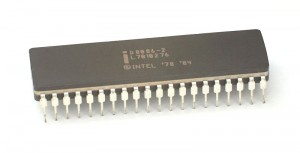
Intel introduces the 16-bit 8086 processor with clock speeds of 10, 8, and 5 MHz. The 8086 would become the basis for the series of processors used in “IBM Compatible” PCs and the x86 family (later marketed under the name “Pentium”) that would dominate the market in the PC era. Ironically, however, it was the modified 8-bit 8088 processor that was used in the original IBM PC, primarily due to factors that would reduce overall cost. The current line of Intel “Core” processors are still based on the same architecture that was introduced with the 8086.
The Breakup of Microsoft … That Never Happened
June 7, 2000
United States District Judge Thomas Penfield Jackson orders the breakup of Microsoft into two companies: one that will develop operating systems and one that will develop other applications. Microsoft immediately announces that it will file an appeal of the judgment. What would have been a monumental event in the history of the technology industry never actually happens, however. The ruling is overturned just over a year later. Microsoft will be sanctioned, but it stays one company.
Really Geeky Modem Technology Patented
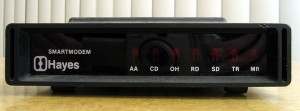
Michael Eaton is granted a patent for the AT Command Set for Modems, which had created a standard language for interacting with modems. Two years earlier, the rights for this command set were purchased by the Hayes Corporation and incorporated into the Hayes Smartmodem 300 as the “Hayes Command Set.” The protocol will become an industry standard used for years to come.
In the early 90’s, needing to use modems so that I could connect to pre-Internet bulletin board systems, I learned the AT command set. I then used and supported modems extensively for about 15 years, and occasionally still do. Because I worked with modems so much, I used to be able to speak the AT command set in my sleep. I know, it impresses the ladies.
Palm Pre Released
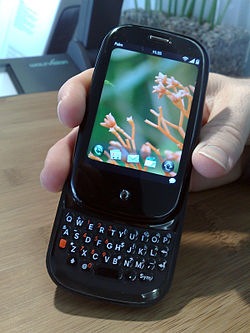
Palm, Inc. releases the Palm Pre smartphone through Sprint in an attempt to regain marketshare, after their Treo line of smartphones is dwarfed by Apple’s iPhone. Featuring the Linux-based Palm webOS operating system, the Pre receives some praise from technical reviewers, but due to poor marketing and the rapid pace in which Apple dominates the New World of smartphones, Palm’s series of phones and the webOS never really have a chance to gain a foothold. Within the course of one year, Palm is purchased by HP for $1.2 billion. One year later, after just 2 months of abysmal sales of their TouchPad tablets, HP halted production of all webOS-based devices. HP later released webOS under an open source license, sold the operating system to electronics manufacturer LG, and the webOS and Palm patents to Qualcomm. Today, LG licenses webOS from Qualcomm as the operating system for their smart televisions, smart refrigerators, and smart projectors. webOS also lives on in open source form.
The Mac Gets Intel Inside
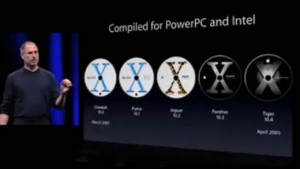
In a keynote address at Apple’s Worldwide Developers Conference, Steve Jobs announces that Macintosh computers will transition from PowerPC to Intel processors and demonstrates Mac OS X running on a computer with an Intel Pentium 4 processor. Jobs revealed at the time that Apple had been secretly preparing for a possible transition to Intel for many years. Unbeknownst to the public, for every version of Mac OS X released, Apple actually had prepared a version running on an Intel processor. By making the transition to Intel, Apple paved the way for the resurgence of the Macintosh computer by making it more compatible with software for Microsoft Windows.

